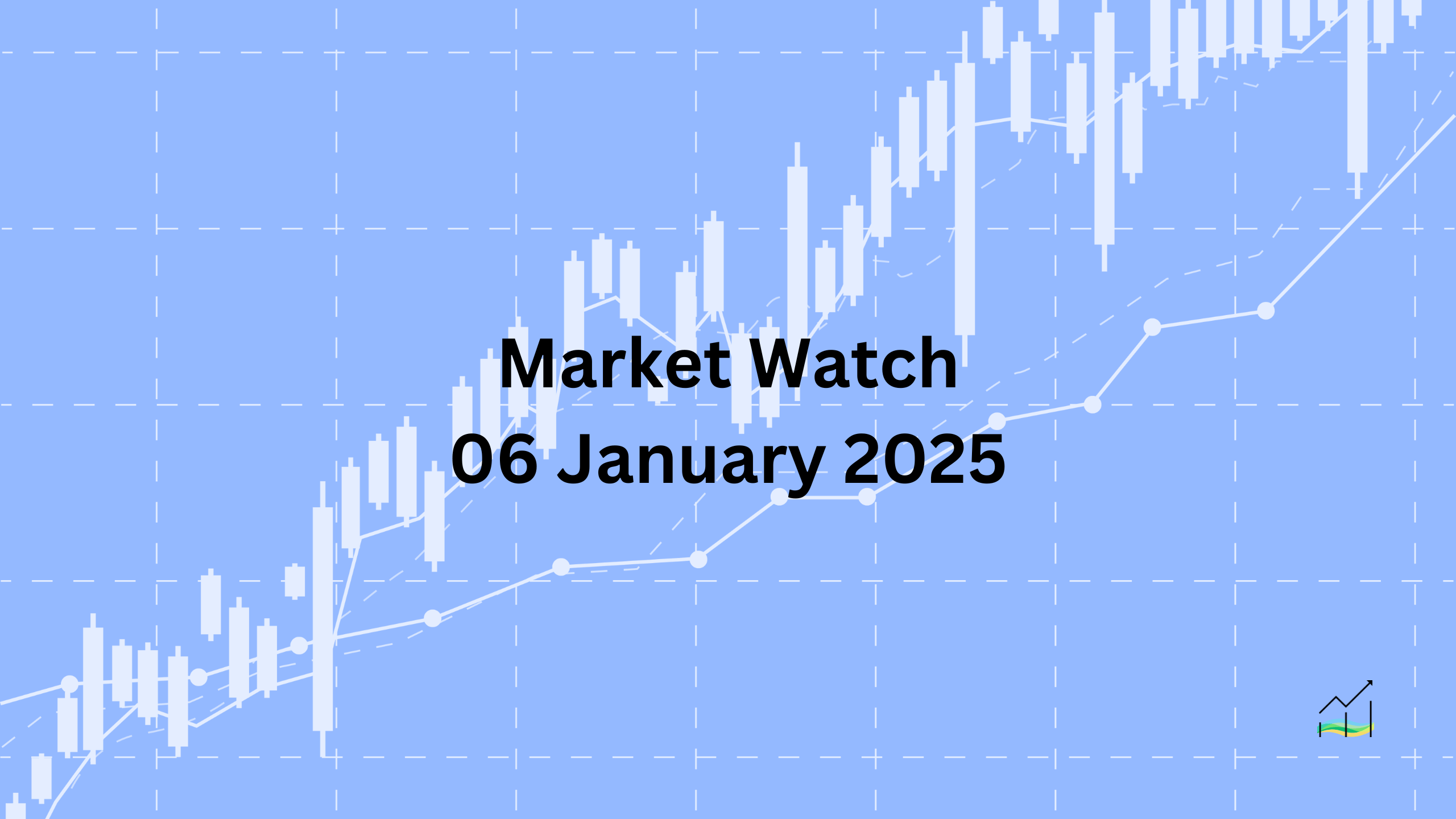06/01/2025 Market Watch

Market Watch: Global Markets Show Mixed Reactions
The US dollar, which rallied last week, has pulled back today but remains mostly within the range set last Thursday and Friday. The Japanese yen is an outlier among the G10 currencies, weakening against the dollar despite the Bank of Japan Governor Ueda's commitment to raising rates if economic and price conditions align. In emerging markets, central European currencies are leading gains, while some Asia Pacific currencies, including the Chinese yuan, are trading lower.
Equity markets show mixed results. Japan's Nikkei fell by about 1.5%, while China's CSI 300 ended slightly lower. Australian and New Zealand stocks managed small gains. In Europe, the Stoxx 600 is slightly up after a nearly 0.5% drop last Friday. US stock futures are looking positive, with NASDAQ futures up around 0.70% and S&P 500 futures nearly 0.50% higher.
Gold, which had reached a two-and-a-half-week high near $2665 ahead of the weekend, is now trading lower, approaching the January 2 low near $2621. Key support is around $2600. February WTI crude oil, which rallied 4.75% last week to $74.25, its best level since early October, made a marginal new high today but is consolidating near the $75 mark.
United States of America
The US dollar is under pressure today as it gives back some of last week's gains. The main focus this week is on Friday's employment report, with a median forecast of around 160,000 jobs, according to Bloomberg. Fed Chair Powell has noted that job growth figures have been overstated, and revisions could potentially lower the average monthly increase by up to 100,000. The FOMC minutes, expected on Wednesday, might offer insights into the Fed's renewed emphasis on price stability, which could be tested by a weak employment report.
Other economic indicators, like the final services and composite PMI, are unlikely to draw much attention. However, the final durable goods data may revise the previously reported 1.1% decline. The Dollar Index remains within the range set on January 2 (~108.25-109.55). Meanwhile, the US Treasury is starting the year with significant sales, including $58 billion in three-year notes and $156 billion in bills today.
Key Points:
- US dollar weakens as last week's gains are pared.
- Focus on Friday's employment report, with a forecast of 160,000 jobs.
- Possible revisions could reduce job growth averages by 100,000.
- FOMC minutes might highlight the Fed's focus on price stability.
- Treasury's large-scale note and bill sales this week.
Australia
The Australian dollar experienced a significant decline of 10.5% in Q4 2024, marking its worst quarterly performance since Q1 2020, when it dropped by 12.7%. This was the steepest fall since Q3 2008, which saw a 17.3% decline. By December 31, the currency hit a two-year low just below $0.6180. After some stabilization at the end of last week, the Australian dollar has shown some recovery today, rising slightly above $0.6250, which is at the lower end of a resistance band that could extend up to $0.6275.
The swaps market currently suggests a 67% probability of a rate cut on February 18, which may be slightly overestimated. The central bank tends to focus more on quarterly data, and the upcoming November CPI release on January 8 is expected to show a slight increase to 2.2% from 2.1%. Additionally, retail sales and household spending reports, due on January 9 and 10 respectively, are anticipated to remain strong.
Key Points:
- Australian dollar fell 10.5% in Q4 2024, its worst quarterly drop since Q1 2020.
- Reached a two-year low just below $0.6180 on December 31.
- Recovery seen today, rising above $0.6250.
- Swaps market indicates a 67% chance of a rate cut on February 18.
- November CPI expected to rise slightly, with strong retail sales and household spending reports upcoming.
Canada
The US dollar reached its highest level in two years against the Canadian dollar last week, closing slightly above CAD1.4460. The Canadian dollar was the weakest among the G10 currencies on Friday, declining by about 0.4%. However, today the US dollar pulled back to around CAD1.4360, marking a four-day low. The widening US-Canada two-year interest rate differential, which hit a new 28-year high of over 136 basis points today, continues to pose a challenge for the Canadian dollar. This differential was near 60 basis points as recently as September.
Adding to the uncertainty is the speculation that Prime Minister Trudeau may resign soon, amid pressure from both his party and the New Democratic Party (NDP), which has indicated support for a no-confidence vote. On the economic front, Canada is set to release its December services and composite PMI today, with the November trade balance due tomorrow. The most significant event of the week is the December jobs report on Friday, where job growth is expected to be about half of November's 50.5k increase.
Key Points:
- US dollar peaked against the Canadian dollar at CAD1.4460, highest in two years.
- Canadian dollar was the worst-performing G10 currency last Friday.
- US-Canada two-year interest rate differential reached a 28-year high of over 136 basis points.
- Speculation about Prime Minister Trudeau's resignation adds political uncertainty.
- Key economic releases: December PMI, November trade balance, and December jobs report.
China
The US dollar closed last week at its highest level since September 2023, above CNY7.32, after Chinese officials had managed to keep it below CNY7.30 in recent weeks. The 2023 peak was near CNY7.35. China's two-year yield, which dipped below 1% last week, has firmed up today, while the 10-year yield continues to fall below 1.60%. The yield gap between China's 10-year bond and the US equivalent is nearing 300 basis points, likely a record.
The People's Bank of China (PBOC) set the dollar's fix at CNY7.1876, slightly lower than the previous sessions, and announced plans to issue bills in Hong Kong this month, aiming to absorb excess liquidity and reduce pressure on the yuan. The Caixin services and composite PMI, reported today, showed a rise in the services PMI but not enough to counteract the decline in manufacturing PMI, resulting in a drop in the composite PMI to 51.4 from 52.3. The December CPI and PPI data, due on Wednesday, are not expected to alter current market views. The US dollar settled near CNH7.3585 before the weekend and is trading slightly softer near CNH7.3470 in European markets.
Key Points:
- US dollar reached its highest since September 2023, above CNY7.32.
- China's two-year yield firmed today, 10-year yield below 1.60%.
- Record 300 bp yield discount between China and US 10-year bonds.
- PBOC set dollar's fix at CNY7.1876, planning bill issuance in Hong Kong.
- Caixin PMI showed slight service sector improvement but weaker overall composite PMI.
- December CPI and PPI data expected Wednesday, unlikely to shift perceptions.
Europe
The euro dropped to approximately $1.0225 on the first trading day of the New Year, marking its lowest level in two years. It stabilized before the weekend and is showing strength today but remains below the January 2 high of $1.0375. The eurozone faces compounded challenges due to Trump's tariff threats, a weak economy prompting expectations of more aggressive rate cuts compared to the Federal Reserve, and political instability in Germany and France hindering bold initiatives.
In Austria, the attempt to exclude the far-right Freedom Party from a new government coalition has failed, allowing the party a chance to form a government. Central Europe faces additional pressure from Ukraine's decision to halt the transit of Russian gas, tightening existing supplies. However, the Dutch benchmark gas price has eased for the third consecutive session. Tomorrow, the preliminary December CPI will be released, with expectations of a 0.4% rise in the headline rate, lifting the year-over-year rate to 2.4%, while the core rate is expected to remain steady at 2.7%. The unemployment rate for November is projected to stay at a record low of 6.3%. Significant euro options are set to expire today (1.36 billion euros) and tomorrow (2.41 billion euros) at $1.03.
Key Points:
- Euro fell to a two-year low at $1.0225 but is trading firmer today.
- Challenges include Trump's tariffs, weak economy, and political instability.
- Austria's far-right Freedom Party gains a chance to form a government.
- Ukraine stops Russian gas transit, impacting central Europe.
- Dutch benchmark gas prices ease for the third day.
- December CPI expected to rise, with the core rate steady.
- Euro options of 1.36 billion and 2.41 billion euros set to expire at $1.03 today and tomorrow.
Japan
Bank of Japan Governor Ueda reiterated his commitment to raising interest rates if the economy and inflation continue to improve, which has pushed Japanese rates up by 2-3 basis points today. The 10-year yield has reached 1.14%, marking a new multiyear high. The swap market now expects a slight increase of more than 11 basis points at this month's meeting. Despite this, Japanese officials have increased their verbal warnings regarding the foreign exchange market, though significant intervention seems unlikely in the near future.
However, the rise in Japanese rates is not providing much support to the yen, which remains the only G10 currency not appreciating against the dollar today. The dollar is consolidating in a range of approximately JPY156-JPY158, testing the upper end. A break above this level would leave JPY160 as the next key technical level. Japan's key economic data releases this week include labor earnings and household spending on Thursday and Friday.
Key Points:
- Governor Ueda reaffirms commitment to raising rates if economic conditions improve.
- Japanese rates rise to a new multiyear high of 1.14%.
- Swap market anticipates a slight rate hike of more than 11 basis points this month.
- Verbal warnings from Japanese officials on foreign exchange, with no immediate intervention expected.
- Yen is the only G10 currency not strengthening against the dollar today.
- Dollar consolidates in a JPY156-JPY158 range, with a break potentially targeting JPY160.
- Labor earnings and household spending data due later this week.
United Kingdom
Sterling dropped to eight-month lows on January 2, dipping slightly below $1.2355, and consolidated through the weekend. The low for 2024 was set in April at $1.2300. While the strength of the US dollar contributed to the decline, sterling’s weakness also reflects growing concerns over the UK economy, which appears weaker than previously anticipated. Despite this, the pound has rebounded today, reaching $1.2490 in early European trading.
Recent economic data also points to a slowdown. The December manufacturing PMI was revised lower to 47.0, matching the 2024 low from January. Earlier today, the services PMI was also revised down to 51.1 from 51.4, indicating that economic conditions worsened in the second half of December. Additionally, there are significant options expiring today and tomorrow, with GBP555 million at $1.25 and GBP400 million at $1.2465.
Key Points:
- Sterling dropped to eight-month lows on January 2, just below $1.2355.
- Weaker-than-expected UK economic data and a strong US dollar pressured the pound.
- The pound rebounded today, reaching $1.2490 in early European trading.
- December manufacturing PMI revised down to 47.0, a 2024 low.
- Services PMI revised to 51.1, signaling a deterioration in economic conditions in late December.
- GBP555 million in options expiring at $1.25 today, and GBP400 million at $1.2465 tomorrow.
© 2025 SKONE Enterprise (003319453-V). All rights reserved.
The content on this site is for informational purposes only and does not constitute financial advice.


